
Hub motor vs mid-drive: which one is better
Electric bicycles are becoming increasingly popular forms of electric two-wheeled transportation for both commuting and pleasure. The two most commonly electric motors used in current electric bicycles are the electric hub motor and the mid-drive motor. Which is the best for your needs?
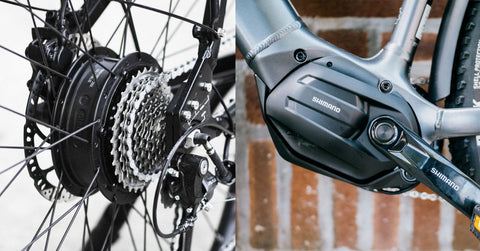
What is a mid-drive motor
Mid-drive motors, which house the motor closest to the center of the bicycle and transfer the power from the motor to the rear wheel via the bicycle's chain drive. Mid-drive motors have become much more common over the past 2-3 years. They are cutting significantly hub motor lead as the king of e-bike motors.

What is an electric hub motor
A bike hub motor is right in the middle of the hub, or in the middle of the wheel (usually in the back wheel). The electric hub motor transfers its drive power directly to the wheel hub. As a rule, the low-maintenance and brushless electric motors popular with manufacturers are used. The motor gets a little bit of juice from the controller and then the motor starts to turn. Then through the spokes onto the tire, and the entire bike gets moving. That's an electric hub motor!
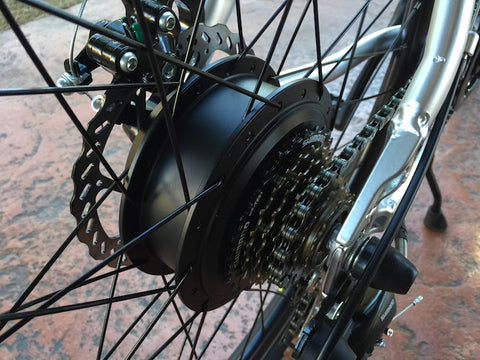
Most e-bikes have a front-wheel hub motor or a rear hub motor. What are they different?
Front-wheel hub motor
Pros:
there are one real advantage to electric bike front wheel hub motors in that while it's powering the front wheel, the cyclist also is powering the rear. Giving great control of the electric bicycle no matter the surface.
Can tackle snow, sand, or gravel better than other motor models.
The cycling sensation of the bike being pulled can be more pleasant than traditional electric bikes.
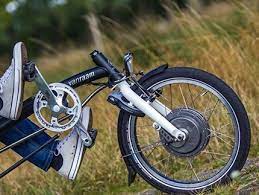
cons:
the electric bike front wheel hub motor has become rare. They almost only occur on cheap e-bikes. As they also have a negative impact on steering behavior and work in an inharmonious manner.
Rear hub motor
Pros:
The rear hub motor is present on practically all-electric bikes because it can accommodate the needs of most cyclists.
They aren't specifically designed to address a single issue for bikers, but they do a decent job of covering the majority of bikers.
The main benefit of a rear hub motor is that it provides good acceleration, which is just what every commuter wants when accelerating from a stoplight.
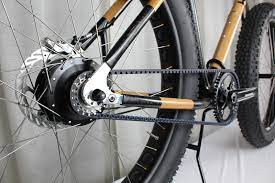
cons:
An electric bike with a rear hub motor is much more pleasant to ride. However, maintaining the balance of driving behavior can take some getting used to. With an electric rear hub motor, no coaster brake is possible and the selection of possible rear derailleurs is somewhat limited.
Mid-drive motor
Advantages:
Strong torque, full power - the main advantage that mid-drive motors have over electric hub motors is their gear ratio. They allow the rider to operate the rear wheel via the same chain and gears as the pedals, which means that a low gear can be selected to power steep climbs or accelerate from a stop with high torque. A mid-drive motor in low gear can climb steeper hills than an electric hub motor with similar power and can climb hills for longer than a hub motor, which could overheat on long steep climbs.
More robust - the mid-drive motor is usually smaller and lighter than a motor hub of similar horsepower. Smaller and lighter mid-size motors are often more robust because they can be incorporated directly into the bicycle frame.
Easier to change tires - changing a tire on a mid-drive electric bike is much easier since you don't have to deal with a heavy bike hub motor. Just change it like on a normal pedal bicycle. Plus, since you can use regular bicycle wheels, you have the freedom to use any wheel, tire, and cassette you want.
Pedal-assist systems - mid-drive motors allow the use of true torque sensors for pedal-assist systems, which adjust the power of the motor based on the force with which you press the pedals measured at the crank.
Disadvantages:
Expensive - they are usually more expensive than an electric hub motor.
Retrofit difficult - retrofitting is also much more difficult because the mid-drive motor usually has to be installed directly in the frame.
More wear and tear - the transmission of energy via the chain and pinion increases the wear and tear on these components of the wheel.
Can't use coaster brake - the use of a coaster brake is usually not possible. However, all other components on the wheels can be installed without any problems.
Hub drive
Advantages:
Cheap - bike hub motors are much cheaper than mid-drives.
Little or no maintenance - one of the biggest advantages of the electric hub motor is that they require little or no maintenance. This fully independent drive system keeps all components inside the engine casing, leaving nothing for you to tamper with or maintain. On the other hand, bike hub motors have zero moving parts aside from their bearings, so there is virtually nothing to wear out. As long as they don't rust or wear out the bearings, they can last forever.
The chain lasts longer - electric hub motors don't connect to the main pedal drive system, the bike hub motors don't add any extra effort to the chain or shifters, and don't cause those parts to wear out any faster. If anything, the chain will likely last longer than a non-electric bike because the hub motor will do more work, allowing the chain to often remain idle.
Disadvantages:
Wheels remove difficultly - those wheels can be difficult to remove from the bicycle. It's not super complicated, usually just washers and a plug, but it can be very overwhelming and if it's not on there right then the entire bike just feels really weird. If you switch out tires often, then an electric bike hub motor can really be a drag.
Can cause motor discomfort - hub motors often rely on cadence sensors for pedal assistance, which only adjust the motor speed based on the pedal speed, and can cause motor discomfort, especially when pedaling or shifting the bicycle around obstacles.
Having a big impact on balance - putting the motor weight either on the front or the back of the bike away from the rider has a pretty big impact on the front-to-back balance.
Not suitable for off-road trails - it's not really a big deal if you plan on riding on the road with pretty casual. But when you get off-road into the trails, it makes a big difference to have that weight bulking you back or kind of pulling you forward.
Summary: hub motor vs mid-drive
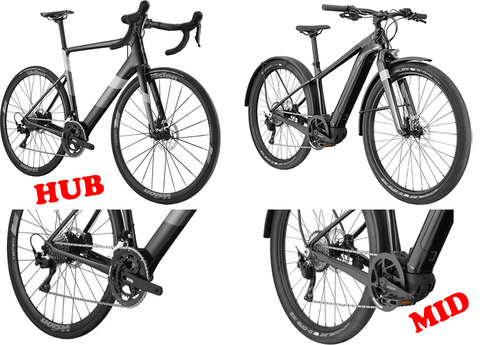
So in conclusion, to choose your motor start from the available budget. With a small budget, the choice falls on the versatile integrated motor or bike hub motor, while if you can spend the money, then you will have to choose according to your needs.
If you want to move around the city and have a snappy vehicle that approaches a moped, the electric bike hub motor version is better.
On the other hand, if you want to do long rides on mixed surfaces or with paths that involve long climbs, you must choose the mid-drive motor.



